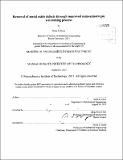| dc.contributor.advisor | Jung-Hoon Chun. | en_US |
| dc.contributor.author | Dave, Neha H. (Neha Hemang) | en_US |
| dc.contributor.other | Massachusetts Institute of Technology. Dept. of Mechanical Engineering. | en_US |
| dc.date.accessioned | 2013-03-28T18:10:09Z | |
| dc.date.available | 2013-03-28T18:10:09Z | |
| dc.date.copyright | 2012 | en_US |
| dc.date.issued | 2012 | en_US |
| dc.identifier.uri | http://hdl.handle.net/1721.1/78167 | |
| dc.description | Thesis (M. Eng. in Manufacturing)--Massachusetts Institute of Technology, Dept. of Mechanical Engineering, 2012. | en_US |
| dc.description | Cataloged from PDF version of thesis. | en_US |
| dc.description | Includes bibliographical references (p. 52). | en_US |
| dc.description.abstract | Data recently collected from an industrial thin film manufacturer indicate that almost 8% of devices are rejected due to excess metal, or unwanted metal on the device surface. Experimentation and analysis suggest that almost half of these defects are caused by incomplete removal of nickel oxides that form on top of the conductive nickel surface throughout the heated environment of the upstream process. This study classified and identified the composition of these excess metal defects, evaluated recommended wet etch methods to remove nickel oxide, and finally proposes a wet etch process that will rapidly remove defects while continuing to maintain the desired semi-anisotropic etch profile, uncharacteristic of most wet immersion etch processes. Results attested that rapid exposure to dilute (40%) nitric acid followed by immediate immersion into a cleaning agent, proprietary nickel etchant, and titanium tungsten etchant removed all nickel oxide defects. Upon implementation, this method has the potential to reduce scrap due to excess metal by 3% and reduce overall etch process time by 25%. In addition, a process was developed to completely etch patterned substrates with high defect density mid process and rework them from raw substrates. | en_US |
| dc.description.statementofresponsibility | by Neha H. Dave. | en_US |
| dc.format.extent | 52 p. | en_US |
| dc.language.iso | eng | en_US |
| dc.publisher | Massachusetts Institute of Technology | en_US |
| dc.rights | M.I.T. theses are protected by
copyright. They may be viewed from this source for any purpose, but
reproduction or distribution in any format is prohibited without written
permission. See provided URL for inquiries about permission. | en_US |
| dc.rights.uri | http://dspace.mit.edu/handle/1721.1/7582 | en_US |
| dc.subject | Mechanical Engineering. | en_US |
| dc.title | Removal of metal oxide defects through improved semi-anisotropic wet etching process | en_US |
| dc.type | Thesis | en_US |
| dc.description.degree | M.Eng.in Manufacturing | en_US |
| dc.contributor.department | Massachusetts Institute of Technology. Department of Mechanical Engineering | |
| dc.identifier.oclc | 829685416 | en_US |
